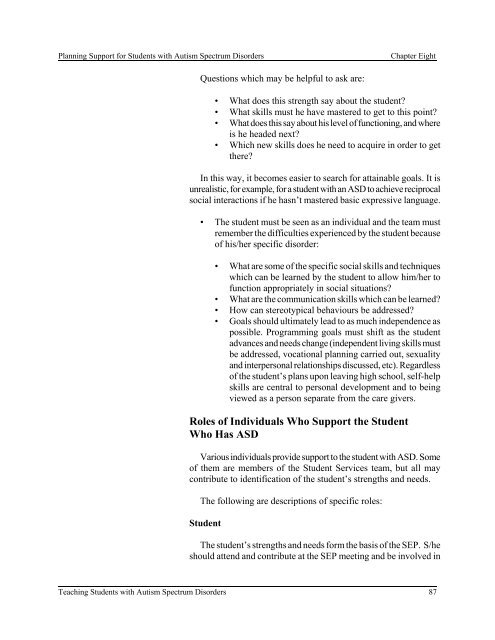Teaching Students with Autism Spectrum Disorders
Teaching Students with Autism Spectrum Disorders
Teaching Students with Autism Spectrum Disorders
You also want an ePaper? Increase the reach of your titles
YUMPU automatically turns print PDFs into web optimized ePapers that Google loves.
Planning Support for <strong>Students</strong> <strong>with</strong> <strong>Autism</strong> <strong>Spectrum</strong> <strong>Disorders</strong> Chapter Eight<br />
Questions which may be helpful to ask are:<br />
• What does this strength say about the student?<br />
• What skills must he have mastered to get to this point?<br />
• What does this say about his level of functioning, and where<br />
is he headed next?<br />
• Which new skills does he need to acquire in order to get<br />
there?<br />
In this way, it becomes easier to search for attainable goals. It is<br />
unrealistic, for example, for a student <strong>with</strong> an ASD to achieve reciprocal<br />
social interactions if he hasn’t mastered basic expressive language.<br />
• The student must be seen as an individual and the team must<br />
remember the difficulties experienced by the student because<br />
of his/her specific disorder:<br />
• What are some of the specific social skills and techniques<br />
which can be learned by the student to allow him/her to<br />
function appropriately in social situations?<br />
• What are the communication skills which can be learned?<br />
• How can stereotypical behaviours be addressed?<br />
• Goals should ultimately lead to as much independence as<br />
possible. Programming goals must shift as the student<br />
advances and needs change (independent living skills must<br />
be addressed, vocational planning carried out, sexuality<br />
and interpersonal relationships discussed, etc). Regardless<br />
of the student’s plans upon leaving high school, self-help<br />
skills are central to personal development and to being<br />
viewed as a person separate from the care givers.<br />
Roles of Individuals Who Support the Student<br />
Who Has ASD<br />
Various individuals provide support to the student <strong>with</strong> ASD. Some<br />
of them are members of the Student Services team, but all may<br />
contribute to identification of the student’s strengths and needs.<br />
The following are descriptions of specific roles:<br />
Student<br />
The student’s strengths and needs form the basis of the SEP. S/he<br />
should attend and contribute at the SEP meeting and be involved in<br />
<strong>Teaching</strong> <strong>Students</strong> <strong>with</strong> <strong>Autism</strong> <strong>Spectrum</strong> <strong>Disorders</strong> 87

















